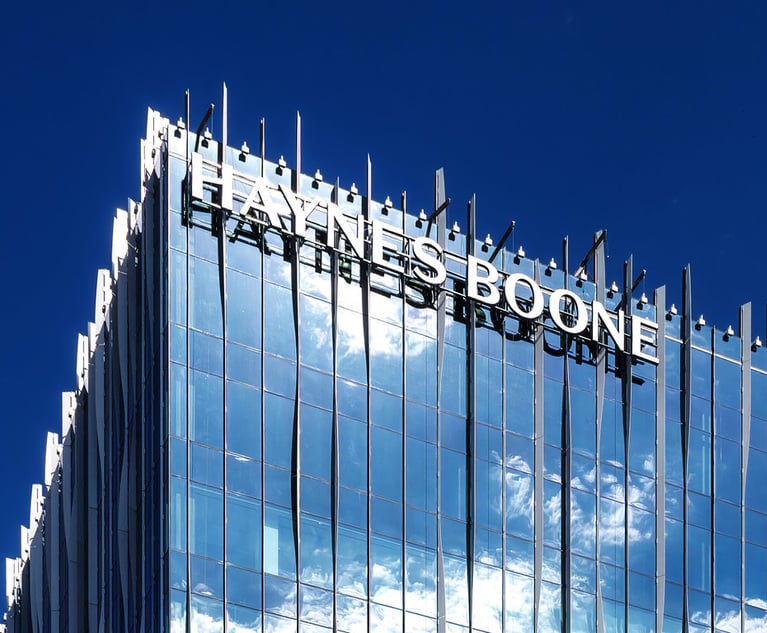New Report Warns of a 'Wake-Up Call' for Stagnant Law Firms
"Consensual neglect?" An annual report from Georgetown University and Thomson Reuters states that many law firms are ignoring drastic changes occurring in the legal market.
January 10, 2018 at 01:00 PM
7 minute read

Most lawyers overestimate the strength of the current market for law firm services, and that is partly why Big Law has for years failed to respond to client demands for efficiency.
As a result, many Am Law 100 and Second Hundred firms are increasingly vulnerable to losing work to in-house lawyers and newer, more nimble competitors. Those are conclusions from an annual report released Wednesday by the Thomson Reuters Legal Executive Institute and the Center for the Study of the Legal Profession (CSLP) at the Georgetown University Law Center.
The CSLP and Thomson Reuters report states that law firms can still succeed in today's market by changing their approach to pricing, managing work and implementing technology as part of an effort to deliver more efficient services.
“Our hope with this is that we can help build a kind of wake-up call,” said James Jones, an author of the report and former managing partner of Arnold & Porter who now serves as a senior fellow at Georgetown's CSLP. “Because in point of fact, I think that law firms can have a real competitive advantage and be significantly successful if they will only do some of this basic stuff.”
The 19-page report, which comes a year after another report issued by Thomson Reuters and the CSLP,includes market data through November 2017 from Thomson Reuters Peer Monitor. The latest report includes the finding that demand across all law firms experienced virtually zero growth last year. Am Law 100 firms, however, saw demand growth of more than 1 percent, while Am Law Second Hundred firms saw demand fall by more than 1 percent.
The top 100 firms also increased their agreed-upon rates by about 3.7 percent last year. The Second Hundred increased those rates by 2.8 percent, according to the report.
While the data depicts a continued stagnant market for high-end legal services, the report is more broadly a diagnosis of the ailments—often psychological in nature—that have prevented firms from responding to the realities of a changing legal market.
The CSLP and Thomson Reuters report states that firms in many cases remain committed to “once-successful strategies even as evidence mounts of their failure.” Citing an article from the Harvard Business Review titled, “Stop Doubling Down on Your Failing Strategy,” the report discusses natural human biases that can paralyze leaders.
Those include “the sunk cost fallacy,” which leads people to see through investments to their completion rather than to cut and run when it is clear those investments will not pay off. Another is “personal identification,” something that prevents leaders from changing course because their reputation is perceived to be tied to a previous strategy.
The report claims that these biases can lead managers to ignore the events that undermine a strategy and double down on their decisions to justify their prior actions, a phenomenon called “consensual neglect.”
“'Consensual neglect' seems a particularly apt description of the strategic posture of many (if not most) law firms in today's rapidly changing market for legal services,” states the report. “Ignoring strong indicators that their old approaches—to managing legal work processes, pricing, leverage, staffing, project management, technology and client relationships—are no longer working, they choose to double down on their current strategies rather than risking the change that would be required to respond effectively to evolving market conditions.”
One reason firms may neglect a changing market, according to the CSLP and Thomson Reuters, is that many of the industry-wide statistics conceal just how much the market has changed.
While the theme of a widening gap between the Am Law 100 and Second Hundred has previously been reported, the CSLP and Thomson Reuters report states that less is understood about how much variation exists among firms even in those groups.
Citing research by Bruce MacEwen of Adam Smith Esq., the CSLP and Thomson Reuters report notes that of the $3.5 billion in nominal increases in Am Law 100 gross revenue reported in 2017, two-thirds of that sum can be attributed to about 20 of the 100 firms.
If gross revenue growth is increasingly limited to a handful of firms, the report claims those firms as a whole are far less profitable than most think. Pointing to a story written last year by Chris Johnson, a former chief global correspondent for The American Lawyer, the report states that law firm profitability metrics fail to account for the cost of equity partners' salaries. Adjusting for that, Johnson found the average profit margin for the Am Law 200 would fall from 38 percent, to about 14 percent.
“What is becoming increasingly clear is that the market in which law firms are required to operate today may in reality be quite different from the one that most law firm partners have fixed in their minds,” states the CSLP and Thomson Reuters report. “So far, the realignment of competition across the legal industry has been limited, but the direction of movement is clear and the pace of change is accelerating.”
The report predicts faster growth for alternative legal service providers such as Axiom Global Inc., Consilio and UnitedLex Corp., the latter of which made headlines in December with a deal to outsource a portion of the legal department of publicly traded DXC Technology Co.
A Thomson Reuters report last year showed the market for alternative legal service providers (ALSP) had grown to $8.4 billion, compared to a $275 billion U.S. market for legal services and a $700 billion market worldwide. But Jones, the CSLP senior fellow and a legal industry consultant, said the size of the ALSP market should not be underestimated.
“If we see ALSPs continue to grow at the rate they have in the past—and some were growing at 25, 30 percent per year—it's not going to be very long before they take a significant chunk,” Jones said. “And I would argue that $8.5 billion is already a pretty big chunk.”
Still, Jones said he was “not really pessimistic” about the prospects for law firms. He said competition for the “middle 60 percent” of legal work will grow increasingly fierce as the top firms more exclusively service the top 20 percent of high-end work and in-house departments keep the bottom 20 percent to themselves.
“To get to that 60 percent, given the types of competitors in the market, firms are going to have [to] work differently,” Jones said. “They'll need to have different staffing models, be more multidisciplinary in the market. And that's the hard part. But I'm optimistic that those that do will meet with some success. And the record indicates that.”
This content has been archived. It is available through our partners, LexisNexis® and Bloomberg Law.
To view this content, please continue to their sites.
Not a Lexis Subscriber?
Subscribe Now
Not a Bloomberg Law Subscriber?
Subscribe Now
NOT FOR REPRINT
© 2025 ALM Global, LLC, All Rights Reserved. Request academic re-use from www.copyright.com. All other uses, submit a request to [email protected]. For more information visit Asset & Logo Licensing.
You Might Like
View All

White & Case Crosses $4M in PEP, $3B in Revenue in 'Breakthrough Year'
6 minute read
Haynes and Boone Expands in New York With 7-Lawyer Seward & Kissel Fund Finance, Securitization Team
3 minute read
Trending Stories
- 1Law School Applications are Up Across the Country. Law Deans Aren't Sure Why
- 2Retention, Development and 'Empowering Teams': This Am Law 200 Firm's Newest Practice Leader Says Objectives Haven't Changed
- 3From Laggards to Tech Founders: Law Firm Innovation Is Flourishing
- 4Judge Receives Supreme Court Reprimand: 'Your Behavior Was Unacceptable'
- 5Contracts Game Changer? One-Sided ADR Provision Overturned
Who Got The Work
J. Brugh Lower of Gibbons has entered an appearance for industrial equipment supplier Devco Corporation in a pending trademark infringement lawsuit. The suit, accusing the defendant of selling knock-off Graco products, was filed Dec. 18 in New Jersey District Court by Rivkin Radler on behalf of Graco Inc. and Graco Minnesota. The case, assigned to U.S. District Judge Zahid N. Quraishi, is 3:24-cv-11294, Graco Inc. et al v. Devco Corporation.
Who Got The Work
Rebecca Maller-Stein and Kent A. Yalowitz of Arnold & Porter Kaye Scholer have entered their appearances for Hanaco Venture Capital and its executives, Lior Prosor and David Frankel, in a pending securities lawsuit. The action, filed on Dec. 24 in New York Southern District Court by Zell, Aron & Co. on behalf of Goldeneye Advisors, accuses the defendants of negligently and fraudulently managing the plaintiff's $1 million investment. The case, assigned to U.S. District Judge Vernon S. Broderick, is 1:24-cv-09918, Goldeneye Advisors, LLC v. Hanaco Venture Capital, Ltd. et al.
Who Got The Work
Attorneys from A&O Shearman has stepped in as defense counsel for Toronto-Dominion Bank and other defendants in a pending securities class action. The suit, filed Dec. 11 in New York Southern District Court by Bleichmar Fonti & Auld, accuses the defendants of concealing the bank's 'pervasive' deficiencies in regards to its compliance with the Bank Secrecy Act and the quality of its anti-money laundering controls. The case, assigned to U.S. District Judge Arun Subramanian, is 1:24-cv-09445, Gonzalez v. The Toronto-Dominion Bank et al.
Who Got The Work
Crown Castle International, a Pennsylvania company providing shared communications infrastructure, has turned to Luke D. Wolf of Gordon Rees Scully Mansukhani to fend off a pending breach-of-contract lawsuit. The court action, filed Nov. 25 in Michigan Eastern District Court by Hooper Hathaway PC on behalf of The Town Residences LLC, accuses Crown Castle of failing to transfer approximately $30,000 in utility payments from T-Mobile in breach of a roof-top lease and assignment agreement. The case, assigned to U.S. District Judge Susan K. Declercq, is 2:24-cv-13131, The Town Residences LLC v. T-Mobile US, Inc. et al.
Who Got The Work
Wilfred P. Coronato and Daniel M. Schwartz of McCarter & English have stepped in as defense counsel to Electrolux Home Products Inc. in a pending product liability lawsuit. The court action, filed Nov. 26 in New York Eastern District Court by Poulos Lopiccolo PC and Nagel Rice LLP on behalf of David Stern, alleges that the defendant's refrigerators’ drawers and shelving repeatedly break and fall apart within months after purchase. The case, assigned to U.S. District Judge Joan M. Azrack, is 2:24-cv-08204, Stern v. Electrolux Home Products, Inc.
Featured Firms
Law Offices of Gary Martin Hays & Associates, P.C.
(470) 294-1674
Law Offices of Mark E. Salomone
(857) 444-6468
Smith & Hassler
(713) 739-1250










